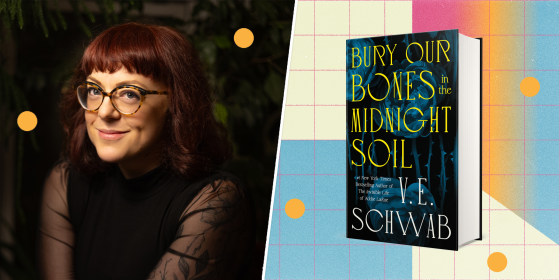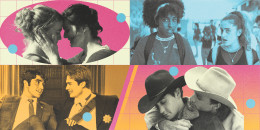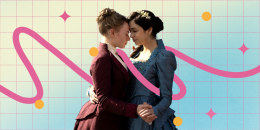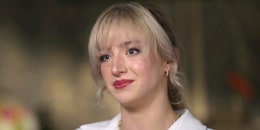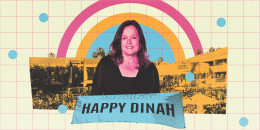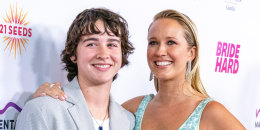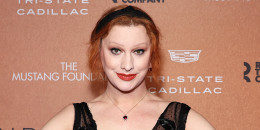For years, V. E. Schwab hasn’t felt "gay enough."
"With quotation marks — obviously it's an absurd concept," she tells TODAY.com. "There is no such thing, and I know that."
Schwab's journey coming out as queer started about 10 years ago, she says. But the hit fantasy author — known for 2013's "Vicious," 2015's "A Darker Shade of Magic," the 2020 BookTok darling "The Invisible Life of Addie LaRue" and more — has long strived to "assimilate" into the genre.
When she started publishing, she downplayed the fact that she's a woman. And though her stories always featured LGBTQ+ characters, (in a 2018 tweet, Schwab notably said all characters in her "Shades of Magic" series "should be presumed queer unless stated otherwise"), she didn't lead with her own "queerness," she says.
"I didn't want to do anything that would limit the growth of readership," Schwab says.
The result was that "no one ever thinks I'm gay," she reflects now. She thought she didn't mind. If blending behind the pseudonym of her initials meant someone may read her books, not knowing the breadth of identities ahead, and learn something? Better than someone not picking up the book at all, she says.
In 2020, Schwab told her coming out story publicly in an essay for Oprah Daily. But it wasn't until her latest novel, "Bury Our Bones in the Midnight Soil," out June 10, that she felt comfortable living, being, existing in that story.
"What I didn't predict and what turned out to be true is the catharsis of writing this book as a gay person," Schwab says. "I did not realize how badly I needed to write this in order to take up the space of this story."
‘I Can't Think of Any Greater Gift’
"Bury Our Bones in the Midnight Soil" follows three women across a 500-year period, with alternating perspectives. The book opens with 10-year-old Maria in 1500s Spain. We next meet Alice, a college first-year in 2019 trying to face her anxiety at a party. Within pages, both Maria (who later renames herself Sabine) and Alice describe themselves — or who they want to be — as "feral."
Then there's Charlotte, or Lottie, born in 1800s England, who knots their stories all together.
All three start as young women chafing against their circumstances, until another woman arrives. (Sabine encounters a widow passing through her home of Santo Domingo, Charlotte encounters Sabine, and Alice encounters Charlotte.) Their stories are different, but end the same: Each woman leaves dead — specifically, as a vampire.
Schwab was inspired by the "classic" vampiric lore — "everything from 'Carmilla' essentially up through Anne Rice," she says.
"If you go back and you look at these classic vampires, they're inherently queer, they're inherently liminal, they represent knowledge and the danger of being exposed to an alternate potential future," she says. "And the idea is that once you're exposed, you can never go back to ignorance."
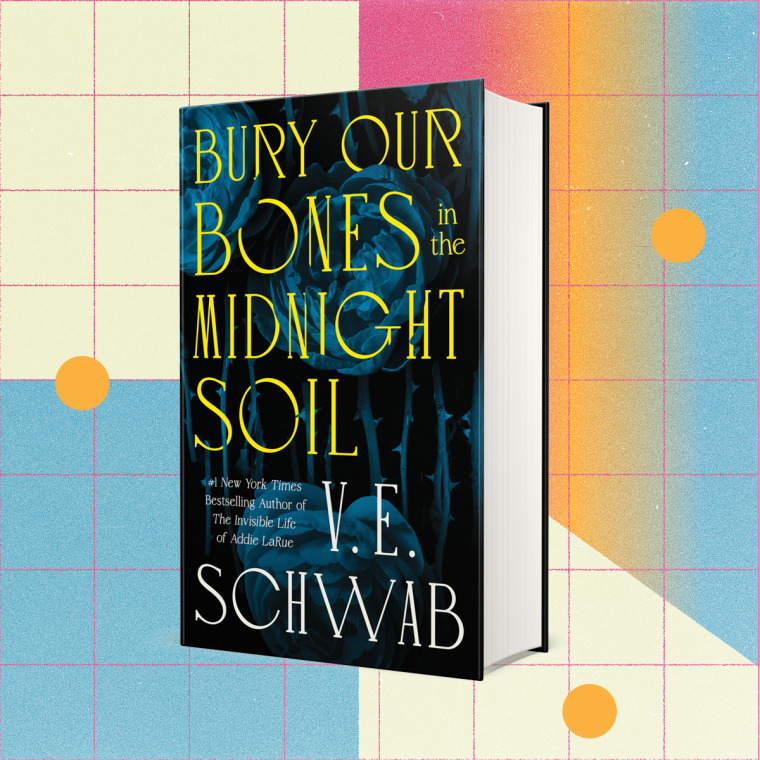
A longtime love of vampires was just one of the "ingredients" that went into "Bury Our Bones." ("I see my stories as a meal," Schwab explains.) Other themes include queer love throughout history and collateral damage, first explored through what Schwab had long been taught about one-night stands.
"I'm an only child, and for some reason, my parents thought the way to keep me safe growing up — I remember this coming in at like, 13, it was a lesson for my future — was to never have a one-night stand," Schwab says, explaining she was taught that by definition, the act involves being in close quarters with a complete stranger and "putting yourself in inherent danger."
"I always thought this was a hysterical take," she adds.
For Alice's storyline, Schwab followed this lesson to its most extreme conclusion. In the spirit of taking on the mantle of a "New Alice" at university, Alice invites a woman (Charlotte) home to have sex ... and wakes up dead, paying the price of Charlotte's desire.
She's robbed of a choice, but she's granted the metaphorical and literal teeth that ensure ultimate survival.
"I think we spend so much time with male vampires as the lead, and I'm like, 'They don't need it,'" she says. "You know who actually needs teeth, is the person who is made to feel small, told to limit their desire, told never to be insatiable, told never to want, told exactly how little they are supposed to take up in the world."
To Schwab, the most important moment in the book occurs when Alice in the present day realizes the she has nothing to be afraid of. No, everyone else fears her.
"The thing about an immortal is that they endure. That is, by definition, what they do. They endure when you shouldn't be able to, and I can't think of any greater gift to give my lesbian women than the sense that they would get to know they would endure," she says.
Writing Herself Into the Story
Speaking with TODAY.com less than two weeks before publication date, Schwab says she's feeling "deep, deep, crashing out in real time-level neuroses." Normally she'd be on deadline for her next project, but she purposefully finished a first draft of her next work ("Victorious," the third and final book in the "Villains" series) early to be present for the release of "Bury Our Bones in the Midnight Soil."
"In many ways, this story is about the three eras of my own queer coming out journey, and going from not knowing who you are, to just wanting to be loved, to being unapologetic," Schwab says. "There's just a lot more nonfiction underpinning the fiction than I'm used to."
Sabine represents the version of Schwab that was able to write a book like this, she says. Sabine is unapologetic about her beliefs, actions and behaviors, even as the novel's "villain." She's fully realized and uninterested in "conforming to anyone else's idea of what a life is," Schwab says.
"I think I had to get to her in my own journey before I could look back at my Alice and Lottie years," she says.
Alice, the youngest of the pack, starts the novel open about her sexuality but struggling to define herself out of the shadow of her sister. She stands in for a version of Schwab who was trying to find her identity while dealing with the "whiplash" of a major event shaking one's foundation. For Schwab, it was realizing she was gay. For Alice, it was waking up a vampire.
Then there's the "Lottie years," or as Schwab calls them, "the toxic years." Charlotte is defined by "desperately wanting to be loved," even at the expense of others.
When asked for one true "villain" of her vampire novel, Schwab gives the potentially hot take of Lottie. ("We do not stan someone who perceives themselves as a victim when they are an abuser," Schwab says.) But all three women make terrible decisions and do awful things. That's, too, a reflection of Schwab's experience coming out and her relationship with publishing.
"For many, many years, even after I had come out, there was a sense that you could not write a queer villain, lest the readership conflate queerness and villainy," she says. "It's such a harmfully reductive take because it suggests that queer characters, and by extension, queer humans, are not afforded the same level of complexity and nuance as their straight counterparts."
By embracing a trio of "messy b----es" to lead the novel, every page, sentence and word, Schwab says, hones in on one purpose: hunger.
"I wanted to write a book about hunger in all of the forms that it takes, specifically for women and femme-presenting people and queer people — the hunger to be loved, to be seen, to be understood, and the hunger to take up space in a world that tries to make you small," she says. "I think that's what I achieved."
Returning to 'the Garden' — and the Easter Egg You Might Have Missed
Before "Bury Our Bones," Schwab didn't think she'd ever put herself "so clearly" into a project again. "The Invisible Life of Addie LaRue" featured a character named Henry, whom Schwab describes as a character she "wrote myself into."
In the 2020 novel, the titular character trades being forgotten by everyone she meets for immortality. Henry is the first person who remembers her after her deal with the devil.
If Addie and her sense of hope are an inspiration, the story of Sabine, Charlotte and Alice is more about the messes immortal beings leave behind.
“I wanted something a little bit angrier,” Schwab says. “I think that’s just an indicator of my own growth as a person. I think that’s an indicator of the landscape of the world. I just spend a lot of my time feeling stifled or angry or what have you.”
It's fitting then that "Bury Our Bones" is set in the same universe as "Addie LaRue." Both are Schwab's take on "urban fantasy, but in a literary way," she says, a world facsimiled of our own that she refers to as "the Garden."
"I wouldn't be surprised if I revisit this space, because it's a place that I really enjoy creatively and aesthetically," Schwab says. "I can see the Garden growing together and apart and in multiple directions."
There's even a cameo from a character in "Addie LaRue" in a blink-and-you-miss-it moment more than halfway through the book, told in Charlotte's perspective. The goal is to establish that in this Garden, "there are multiple kinds of magic and wonder and monstrosity just intertwined with our time and place and our history."
Schwab says only eagle-eyed readers may spot the reference. And though she calls it the "loosest thread" she'd likely ever tie between her Garden books, it has consequences for the wider story.
"It has a repercussion if readers stop and think about it, which is that these characters are occupying the same terrain," Schwab says. "They are coexisting in the same landscape. Addie's history has at some point tangled with one of our vampires.'"
